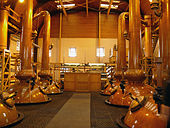| Revision as of 11:54, 27 September 2019 edit165.225.80.233 (talk)No edit summary← Previous edit |
Revision as of 11:58, 27 September 2019 edit undoRobvanvee (talk | contribs)Extended confirmed users, Pending changes reviewers, Rollbackers67,235 edits Reverted 3 edits by 165.225.80.233 (talk): Please be sure to source your edits (TW)Tag: UndoNext edit → |
| Line 20: |
Line 20: |
|
| Type 1 = ] |
|
| Type 1 = ] |
|
| Age 1 = 14 Years |
|
| Age 1 = 14 Years |
|
| Cask 1 = Sherry and bourbon |
|
| Cask 1 = |
|
| ABV 1 = 46% |
|
| ABV 1 = 46% |
|
| Brand 2 = Clynelish 20 year old Bi-centenary bottling |
|
| Brand 2 = Clynelish 1992 Distillers Edition |
|
| Type 2 = ] |
|
| Type 2 = ] |
|
| Age 2 = 20 years |
|
| Age 2 = 15 years |
|
| Cask 2 = Sherry |
|
| Cask 2 = |
|
| ABV 2 = 57.3%% |
|
| ABV 2 = 46% |
|
| Brand 3 = Clynelish Distillery Only Bottling |
|
| Brand 3 = Clynelish Distillery Only Bottling |
|
| Type 3 = ] |
|
| Type 3 = ] |
|
| Age 3 = Non aged statement |
|
| Age 3 = N/A |
|
| Cask 3 = Bourbon |
|
| Cask 3 = |
|
| ABV 3 = 48% |
|
| ABV 3 = 57.3% |
|
|
|
|
|
}} |
|
}} |
| Line 37: |
Line 37: |
|
|
|
|
|
] |
|
] |
|
|
The original Clynelish distillery was built in 1819, adjacent to the present operational Clynelish distillery which was built in 1967. The original distillery briefly ran side-by-side with the new one (Clynelish A and Clynelish B) but for financial reasons closed in 1968. However, the original distillery was reopened in May 1969 and ran until July 1983. During this time it was renamed Brora. It produced a heavily peated whisky to supply for blending; this was done to cover a shortage of ] whisky available for blends, reportedly caused by the rebuilding of the Caol Ila distillery (reported during the Manager's Tour of the distillery in September 2015). Following closure in 1983, Brora whisky has become one of the most rare and desired whiskies in the world, costing around one thousand pounds a bottle. |
|
The original Clynelish distillery was built in 1819, adjacent to the present operational Clynelish distillery which was built in 1967. |
|
|
|
|
|
|
|
Clynelish has had a strong connection with ] blended whisky for many years. Around 95% of the spirit is used in Johnnie Walker, Most commonly found in the Gold Label Reserve |
|
Clynelish ran at the original site from 1819 up until 1967, when production needed increased. In 1967 Clynelish production moved to the present distillery. The two distilleries ran side-by-side as Clynelish A and Clynelish B to make sure they had perfected the spirit in the new distillery, as they did not want the taste/profile to change. They then shut the original site down. |
|
|
|
|
|
It was the following year in 1968 that Caol Ila faced their drought. They shut for a year and did refurbishments. Caol Ila produce a heavily peated whisky on Islay, which supply for blending. With this shortage, Clynelish re opened their original distillery, under the name Brora Distillery, which produced a peated whisky to replace Caol Ila in the blends. This went into the blends for the first year and then continued making this spirit until 1983, when the distillery got mothballed. Lots of distilleries were closing in the 80's. Following its closure in 1983, Brora whisky has become one of the most rare and desired whiskies in the world, costing around one and a half thousand pounds a bottle. Broras latest release was their 40 year old bottle to celebrate their bi-centenary, releasing 1819 bottles, each numbered, to represent the first year the distillery was in production. This bottle is at a RRP of £4,500.00. Similarly, Clynelish did a bi-centenary bottling of a 20 year old Clynelish Spirit, with the same number of bottle produced, at a RRP of £450.00. |
|
|
|
|
|
Clynelish has had a strong connection with ] blended whisky for many years. Around 95% of the spirit is used in Johnnie Walker, Most commonly found in the Gold Label Reserve, nicknames after the 18th century gold rush Brora had. Due to this, locals used Brora water sources to go gold panning and because Clynelish drew their water from the Clynemilton Burn, where you could go gold panning, they used to say Clynelish was like drinking liquid gold - hense the namesake and inspiration behind the naming of the Johnnie Walker Gold Label Reserve. |
|
|
|
|
|
|
==References== |
|
==References== |
The original Clynelish distillery was built in 1819, adjacent to the present operational Clynelish distillery which was built in 1967. The original distillery briefly ran side-by-side with the new one (Clynelish A and Clynelish B) but for financial reasons closed in 1968. However, the original distillery was reopened in May 1969 and ran until July 1983. During this time it was renamed Brora. It produced a heavily peated whisky to supply for blending; this was done to cover a shortage of Islay whisky available for blends, reportedly caused by the rebuilding of the Caol Ila distillery (reported during the Manager's Tour of the distillery in September 2015). Following closure in 1983, Brora whisky has become one of the most rare and desired whiskies in the world, costing around one thousand pounds a bottle.

